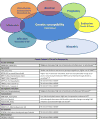Personalizing Risk Stratification for Sudden Death in Dilated Cardiomyopathy: The Past, Present, and Future
- PMID: 28696268
- PMCID: PMC5516909
- DOI: 10.1161/CIRCULATIONAHA.116.027134
Personalizing Risk Stratification for Sudden Death in Dilated Cardiomyopathy: The Past, Present, and Future
Abstract
Results from the DANISH Study (Danish Study to Assess the Efficacy of ICDs in Patients With Non-Ischemic Systolic Heat Failure on Mortality) suggest that for many patients with dilated cardiomyopathy (DCM), implantable cardioverter-defibrillators do not increase longevity. Accurate identification of patients who are more likely to die of an arrhythmia and less likely to die of other causes is required to ensure improvement in outcomes and wise use of resources. Until now, left ventricular ejection fraction has been used as a key criterion for selecting patients with DCM for an implantable cardioverter-defibrillator for primary prevention purposes. However, registry data suggest that many patients with DCM and an out-of-hospital cardiac arrest do not have a markedly reduced left ventricular ejection fraction. In addition, many patients with reduced left ventricular ejection fraction die of nonsudden causes of death. Methods to predict a higher or lower risk of sudden death include the detection of myocardial fibrosis (a substrate for ventricular arrhythmia), microvolt T-wave alternans (a marker of electrophysiological vulnerability), and genetic testing. Midwall fibrosis is identified by late gadolinium enhancement cardiovascular magnetic resonance imaging in ≈30% of patients and provides incremental value in addition to left ventricular ejection fraction for the prediction of sudden cardiac death events. Microvolt T-wave alternans represents another promising predictor, supported by large meta-analyses that have highlighted the negative predictive value of this test. However, neither of these strategies have been routinely adopted for risk stratification in clinical practice. More convincing data from randomized trials are required to inform the management of patients with these features. Understanding of the genetics of DCM and how specific mutations affect arrhythmic risk is also rapidly increasing. The finding of a mutation in lamin A/C, the cause of ≈6% of idiopathic DCM, commonly underpins more aggressive management because of the malignant nature of the associated phenotype. With the expansion of genetic sequencing, the identification of further high-risk mutations appears likely, leading to better-informed clinical decision making and providing insight into disease mechanisms. Over the next 5 to 10 years, we expect these techniques to be integrated into the existing algorithm to form a more sensitive, specific, and cost-effective approach to the selection of patients with DCM for implantable cardioverter-defibrillator implantation.
Keywords: cardiomyopathy, dilated; death, sudden, cardiac; defibrillators, implantable.
© 2017 American Heart Association, Inc.
Figures



References
-
- Pinto YM, Elliott PM, Arbustini E, Adler Y, Anastasakis A, Bohm M, Duboc D, Gimeno J, de Groote P, Imazio M, Heymans S, Klingel K, Komajda M, Limongelli G, Linhart A, Mogensen J, Moon J, Pieper PG, Seferovic PM, Schueler S, Zamorano JL, Caforio AL, Charron P. Proposal for a revised definition of dilated cardiomyopathy, hypokinetic non-dilated cardiomyopathy, and its implications for clinical practice: A position statement of the ESC working group on myocardial and pericardial diseases. Eur Heart J. 2016;37:1850–1858. - PubMed
-
- Hershberger RE, Hedges DJ, Morales A. Dilated cardiomyopathy: The complexity of a diverse genetic architecture. Nat Rev Cardiol. 2013;10:531–547. - PubMed
-
- Bansch D, Antz M, Boczor S, Volkmer M, Tebbenjohanns J, Seidl K, Block M, Gietzen F, Berger J, Kuck KH. Primary prevention of sudden cardiac death in idiopathic dilated cardiomyopathy: The cardiomyopathy trial (CAT) Circulation. 2002;105:1453–1458. - PubMed
-
- Strickberger SA, Hummel JD, Bartlett TG, Frumin HI, Schuger CD, Beau SL, Bitar C, Morady F. Amiodarone versus implantable cardioverter-defibrillator:Randomized trial in patients with nonischemic dilated cardiomyopathy and asymptomatic nonsustained ventricular tachycardia–AMIOVIRT. J Am Coll Cardiol. 2003;41:1707–1712. - PubMed
-
- Bardy GH, Lee KL, Mark DB, Poole JE, Packer DL, Boineau R, Domanski M, Troutman C, Anderson J, Johnson G, McNulty SE, Clapp-Channing N, Davidson-Ray LD, Fraulo ES, Fishbein DP, Luceri RM, Ip JH. Amiodarone or an implantable cardioverter-defibrillator for congestive heart failure. N Engl J Med. 2005;352:225–237. - PubMed
Publication types
MeSH terms
Grants and funding
LinkOut - more resources
Full Text Sources
Other Literature Sources
Medical
Miscellaneous

